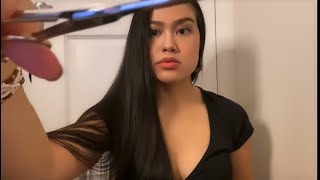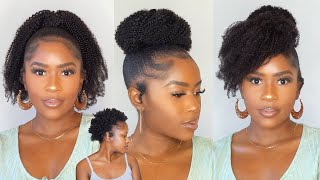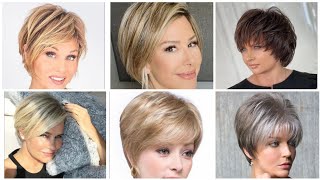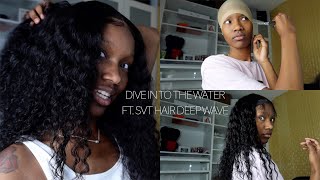Full Step By Step A-Line Bob Haircut Tutorial
- Posted on 07 April, 2022
- Bob Hairstyles
- By Anonymous
Purchase The TriRazor Here:
https://bit.ly/TriRazor
Purchase My Scissor Here:
http://bit.ly/mattbeckscissor
Purchase My Favorite Combs Here:
http://bit.ly/favoritecombs
Purchase Ergo Brushes Here:
http://bit.ly/ergobrushes
Purchase My Favorite Clips Here:
http://bit.ly/myfavoriteclips
TEXT ME! 215-608-2612
Create a FREE Profile and Watch Hundreds of Hair Education Videos Here!
https://bit.ly/FreeSalonEducation
Shop the FSE Store Here!
https://bit.ly/ShopFSE
Get the FSE NOW App!
iPhone: https://bit.ly/FSENOW
Android: https://bit.ly/FSENOWGoogle
Follow me on Instagram: https://bit.ly/FSEINSTAGRAM
Follow me on Twitter: https://bit.ly/FSETWITTER
My goal with this haircut is to make sure that i follow the angle, follow the chin line and have a little bit of a forward fall to the front of the haircut. So i don't want to have it super extreme. I think when people think triangular, they over direct everything really far back and then it becomes too extreme in the front. I want it to be nice and soft, i'm also going to cut it with a center parting. That way, i can work on staying balanced on both sides so center parting. So just look right over the nose comb it back make my first part. I don't have to go all the way down center back at first i'll, continue that after i get this hair out of the way so we'll saturate the hair, i want to make sure that i keep the hair, nice and saturated the entire time. You want to keep only your elevation, your tension, your finger angle, all of that stuff, consistent, but also um. The fabric of the hair should be consistent as well all right, so we're going to section the hair away now what i'm going to do just so. I can kind of cut this in half, i'm going to work across the occipital bone from the occipital bone to behind the ear, pretty standard sectioning, all right, so we'll comb this over. I'M going to do the same thing on this side, so i'll comb, the hair in the direction i want it to go, and then i'm going to take a parting across the occipital bone over to behind the ear. If i put the comb flat just like this, you can see the angle that is created from the difference between this angle and up here this angle and then obviously here this angle. This is a round surface. So if i'm holding the hair here - and i continue up the head shape - that elevation gets lower and lower as you go, even though your angle stays the same, so it's not so much about finger angle, we're taught in school that this is 45. This isn't 45. 45 at this point of the head is more like this right but 45 at this point of the head is like this, so you have to be really well aware of what the head shape is doing, because your angle is going to reflect and the weight and The density and everything in the haircut is going to reflect the finger angle that you have so i'm going to part this side out of the way. So the way i'm going to work this triangular graduation is, i want to make sure, i'm working on a diagonal. The same angle that i want to create here right so that diagonal should follow through to the jawline. So i take that first parting, and this is basically going to be 90 degrees straight out from the head and i'm going to cut my line so bringing it back to me and cut the line. This is going to be a traveling guide. What i don't want to do is start over directing everything right away back here, because that'll already push a lot of weight right behind. I want it to be more consistent across and then start to take its um dive down. Now those of you guys that get a hole back behind the ear. First off, don't freak out about a hole because sometimes a hole can happen, but honestly we're going to cut into this. So you can see how the the hairline right here gets a little bit weaker. All of that in the dry cut i'm going to take off and i'm going to follow this line that i'm creating. So i'm really focused on the weight line and the interior. Not so much the line on the exterior, if you come around and you just cut shorter layers in here, then you're cutting around shape anyways. So you just need to know what you're doing i'm cutting triangular. So as i get to the side here, everything is coming back to me: i'm not allowing my hand to go into that corner because it's triangular, so i don't want to take off the corner. I guess you should say, and then i finish off using the line from that previous section. So now you will see as i comb that down here. That'S our weight. This you've got your line, but then it goes up and away, but that's only because the hairline goes up and away. We could continue on this side cut this whole side. If we wanted to, i personally like to work both sides to make sure i have a nice balance shape before i move on to the rest of the cut, we're going to change up our hand, positioning a little bit, i'm going to take a small diagonal forward. Parting that mimics the chin line or the jawline, not the chin line. We got the head tilt forward now, here's the hardest part the right side becomes harder because right away, my elbow needs to go in the air in order to keep my fingers pointed down to get that consistency of my combing into the new section already. As i push this hair in, i want to push it over and sometimes you can push it a little too far. Sometimes you have lower elevation. So that's the tricky part, that's my line. So that's what i want to continue this section into. So i hold this up in my hand. I can see my line through there and that's what i want to mimic in the haircut so two inches up when i say two inches up, i'm not really being that specific. But i'm already looking at it, and i can see that it's two inches because i look at where the comb starts to bend on the head right, so we're seeing here this bend right here. That'S where i want to, because that's where i know that the head shape is moving, so i want to make sure that that's where i'm staying in line with, so that is our line working through the back. So now i'm going to connect vertically straight out from the head, so i grab not even half an inch, not even half an inch to start this um the thicker, your section that you grab of hair. What happens? Is you pinch that hair together and you're already over directing it so anytime, then you take a new section. You get a diffused guideline because you're already, because you're smashing it all together so to get the strongest guideline. You want to make sure that you're not over directing too much hair pinching it in so less than half an inch here to start and i'm going to work that line. This is where it's going to turn more into that 45 degrees off the head shape. There'S 90 right so 45 is about here. That'S the angle. I want to create that'll start to build up that nice little bit of weight in there, which you can kind of see happening i'll, show you more in a little bit. So this is what i've cut. So far about an inch worth of hair, i'm going to take half of that and push it away. So i don't get involved with it and i'm going to bring just this new section, a quarter of an inch of hair into that previous. Bring it right here and cut my line. This is where the head starts to curve this way right. So i don't want this to change. I want it to start to dip. So, instead of going any more around this corner, i just bring everything straight back. It goes from going straight across now dipping because the head shape you're playing with that whole curve. This way, not only the over direction, that's that side. So, let's move to the side here we're going to do the same thing. So now you can see that nice dip. You can see that bob shape happening, see how that shape there works through to her jawline. I think i'm going to work one more couple inch section then we'll blow it dry because i really want to get the shape in there. So i take my next two inch right at the division point when i say division point i just mean basically, the middle of the ear divides the back and the front. So same thing guys. I know it's a little repetitive, but that's what cutting a precise bob is so center we're going to go quarter of an inch again in the back, just like the previous panel that we cut. The only thing you want to decide here is: do you want to keep building that weight from here out or do you want to start to round it up right? Do you want the weight to sit a little higher or a little lower? That'S all! Based on your elevation from this point, you've got the head curving. This is where we stopped cutting right. So if you want it to be about 45 degrees, for me, that's going to be a a little bit higher elevation than you would probably think. So. I pull this out from the head here and i comb it up and pretty much straight out, but you could see if that's 90 - that's about 45 right. So i just it's not that you have to be that specific, but just know that the higher the elevation at this point, the lighter that um graduation, is going to be like it's very easy to just now all of a sudden drop it down. And then you see it goes a little weird because i'm not at where my guy really is, but some people just cut that off um just to move it in because that's where they think their hand should be. You got ta bust. What you're doing in the shape you're creating as i round this corner, everything gets a little shorter, tighter here. So when i bring this back, i cut my line here normal, but then right here see where that disconnects right there, that's, okay, let it disconnect that's gon na start to build our forward shape that we're getting here. You can see the flow of the weight and it starts to dive down right there. So i'm going to do the same here blow drying working with a flat wrap technique, wrapping it around the head really. What i want to do is just form the hair to the head shape so then down it's got that nice bevel already to it, also helps smooth the hair nice, i'm just going to work the iron into the hair and just smooth it out really just working With the head shape here, so the goal here is to look at the weight within the haircut, not to look at the shape on the outline like this, you can customize. Like you see, people do like different shapes within that the hairline. All of that has nothing to do with, like the actual shape of the haircut and you're, not doing that within the wet cut. Now you won't want to go in here and just go full blown with your blade. What that's going to do is push the hair, then you end up with shorter pieces than you wanted and you're not going to get your line so just go in comb, the hair down and i'll work with scissor. Just like this and i'll start to etch the hair away, little by little use the tip of the scissor across this way, you're not pushing the hair, and you get the line that you're going for. My biggest thing is really focusing right now on keeping that line balanced and following my weight line, which is above, which is here. So i want this line to match my weight line, and it just keeps the haircut looking nice and balanced and to my eye looks the best. Then you can go in with a little bit flatter blade just to make the line a lot harder and sharper we're going to cut the sides. The sides are pretty simple, because you stick to the very similar way of just bringing it straight back and i will wet down just a little bit of this side as well. It was already dry just because i want to have that consistency. There'S a few different ways: you can do this. If you want extra heaviness, then you could start here and just work your way across i'm going to lighten it and then i'm going to shift into creating that line. So i'm going to kind of follow it diagonally. I think that'll work the best in this case it'll also really allow this hair here to lay nice and soft on the top all right. So i take that parting and i connect that here. I'Ve got my disconnection and then eventually i will be running out of hair that will reach back there. This is all behind the ear. Now i'm going to take more hair, i'm going to work diagonal forward along that jawline and bring everything back to this point. So as of right now that first section there's not a whole lot to cut here i'll, take another diagonal, bring it down to me a little more to cut so again i'll, just work a flat wrapping technique around the head. I'Ll just do a little bit of ironing real quick goal when you're smoothing hair to cut it dry is to make sure that there's no kinks and creases in it. So now we've got our dry almost done bob. So what i want to do is just go in and just soften some of this heavy weight. This is very bulky very squared off looking, so i'm going to bring that line in what i want to do is i want to take some of this hair out. Just like this, and i'm going to start underneath here and i'm going to work, that's my perimeter line. So i want some of that to fall out and then i'm going to do a tease, cutting technique which is a half open, half close of the scissor, which just removes some of that bulk. This technique that i'm doing here creates more of a soft effect. Yes, you can do this on curly hair. I actually really love this technique on curly hair and that the only reason i'm over directing it back, because that keeps that triangular kind of forward feel to the haircut. So now it's already getting much lighter on the side and instead of having this squared off feel which was the old haircut, the old perimeter. I can now cut right into that line and create a more triangular perimeter. I'M going to go right into it and you can see with the t's cutting it makes it nice and light on the edge as well, so that hair easily kind of comes back. Now, i'm going to do the same thing on this side, you





Comments
anglebobcut: Great tutorial. Very skilled stylist and an even better communicator. Love this cut.
Patrick Hartle: Stunning! Loving the coloured lines that flash over the head to show the direction and view
Regina Ferri: Beautiful hair cut. Perfection!
Laura A: After 30 years in the industry, this is my all time favorite cut. It's perfect for all hair types and it's such a classic it never goes out of style. Thanks for such a great tutorial.
Marilyn: Perfección ❤️❤️❤️
Look, It's Grandma!: Silly question from a newb barbering student: When you use a traveling guide, are you orbiting around the head along with the guide so that you're always standing behind it? Oh, and could you use a trimmer on the back hairline instead of shears?
Aiden McDonnell: Absolutely fantastic explanation.....thanks matt
ryan border: I trained at Sassoons-he demonstrated this very well-good job
gull masoma: Haircuts are now even easier with the help of this video
Bharti Makwana: So beautiful and love ur technic how u cut ✂️ hair Bob in back and front long
Sean Simms: The difference the lines and angles make is astounding!! I see this haircut in an entirely different way
Natasha Slev: Me encantó.
harshada bhutal: So stunning just love it man
Angela Misinonile: Great tutorial . What about curly hair and dried ✂️. Can you teach me? Please. Thank you.
Kathy Wilson: Will this haircut work for fine or very fine hair ?
Haneen Jameel: It's my favorite haircut that I love to do for my customer. Still not best with it.
Angelina Carraway35: Can u do a video on a shaved undercut with long side bangs?
Delveen Salar: Love the cut, so you used 45 degree and 90degree angles
Jyoti hair and makeup academy💇💃: No words sir just speechless
Shaazia Khurram: Awesome superb amazing love your cut always from Pakistan
gull masoma: Thank you very much
GinaLicious: Isn’t this called a stacked or elevated bob?
Tehami Shah: You are a great person
Y AH: Matt can you please change the direction of the camera to face the back of the mannequin head? I’d like to see the back when your cutting because it makes it difficult to see your sectioning when your doing hair cuts. Great cut though, but pleaseeee change the angel of the camera.
ubaid hussaini: Outstanding cutting sir for beginners from Pakistan mussarrat jahan
Peg B: Super cute
grlnexdoorable: You lost me at, "center part".
R,:
stylish bapi: Big fan sir...
Orquidea Penaloza: ❤❤
Leon Toni: ♥️
Фатима Болатаева:
Adrian Gomez: ❤️❤️❤️